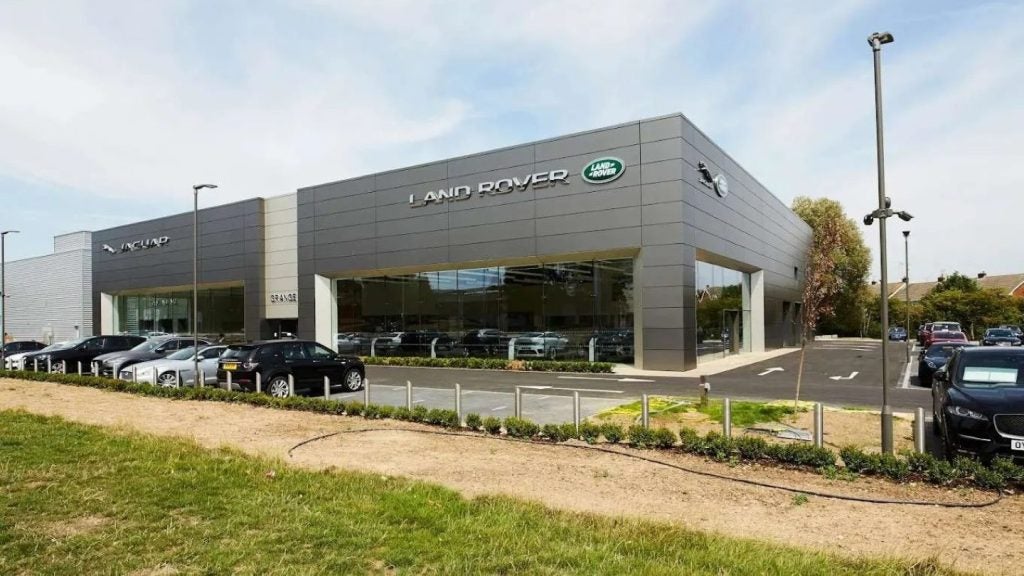Motor Finance brought a
number of experts together for a round table to talk about the
potential for point of sale finance and its role in helping the
industry prosper.
This month, Motor
Finance, in collaboration with Frontline Solutions, invited a
collection of point of sale experts to attend the first of 12 round
table discussions on the future of the dealer finance
market.
The following pages highlight
the following afternoon of debate and discussion, in which brokers,
lenders and independent consultants made clear their feelings and
opinions on three main topics:
- The Consumer Credit
Directive - Subprime motor
finance - The future of personal contract
hire


US Tariffs are shifting - will you react or anticipate?
Don’t let policy changes catch you off guard. Stay proactive with real-time data and expert analysis.
By GlobalDataHow has the introduction
of the CCD affected your business to date?
Shamus Hodgson:
I think it’s probably affected us all in a very similar way – it
has increased our workload over the last few months, regardless of
how our respective companies have chosen to implement
it.
From a funder perspective it has
certainly been a lot of extra burden over the past six months or
so, and particularly in the past two months. We probably all agree
that the way the legislation was drafted was not necessarily as
directive as it could have been and therefore was open to a large
degree of interpretation.
A lot of the additional work has
been working through the legislation to make sure we have a firm
understanding of what’s required of us, because the repercussions
of not getting it right are severe.
I think, to a certain extent,
the anxiety we are all feeling comes down the line from the
experience of PPI, and partially explains why we are experiencing
different approaches from different lenders. Thanks to the
information from the regulatory bodies being less than clear, we
have often had to take independent advice because of the risk to
our businesses – and that advice is going to be different from firm
to firm.
It will align in time between
companies – as more test cases come to court, things will come to
light that we don’t know right now.
Ian Smith: For
us, the bulk of the work was only really in the last six to eight
weeks before we went live on 1 February.
 Did we realise the
Did we realise the
true amount of work that needed to be done, particularly from a
systems point of view? I think it is fair to say we are still
playing catch-up on one or two systems issues that were deemed to
be less important to making sure we could carry out business as
usual.
There was a lot of concern
around the industry about the impact of the 14-day right of
withdrawal, and perhaps a lot of misinformation around as well,
among the retailers rather than the lenders.
Having said that, since we have
gone live we have had only a couple of cases come to light where
the customer has wanted to exercise his right to
withdrawal.
It is still very early days, but
I think as soon as there is more awareness in the marketplace and
among consumers – and, of course, when direct lenders start
returning to the market – there probably will be an increase in
it.
Lee Streets: It is an ongoing
process, and it causes us some pain. In the last three to four
months, just keeping business going as normal has caused a lot of
work behind the scenes.
This has been caused by the
simplest of changes – such as a finance company deciding they wish
to include the dealership on the SECCI. That is an unbelievably
painful process involving us having to set up hundreds of dealers
just to achieve one thing.
The other major issue for us is
the interpretation of the need for training for dealers as well. I
think probably one of the most interesting things from my
perspective, sitting in between the dealer base and the funder
base, is the completely different take on CCD that each side has
had.
From a funder perspective, so
far it has all been about process and systems, while from the
dealers, the attention is all focused around avoiding mis-selling.
Their big concern is that in two to three years’ time we will have
hundreds of cases coming out from claims management companies where
we have not done our selling process correctly.

Graham Hill: In
my opinion, the whole handling of CCD has been a disgrace. No one
seems to have any idea where we are with regulation.
This is meant to make life
easier for consumers and small businesses, but it is just making
things more confusing. I think the industry and the FLA needs to do
something about this.
We knew all this was coming in
April last year, but the period of panic is still continuing –
legislation has been changing right to the last minute.
As a broker, without the benefit
of day-to-day involvement with the regulators, when I want the
information on CCD I go to the internet – only to find out that
most of the guidance written by big law firms three months ago is
outdated and wrong.
There is nothing definitive for
brokers, and certainly nothing explaining things clearly to the
public.
We ought to be warned by what
happened with the implementation of the CCA. The most ridiculous
thing was how voluntary terminations have remained in the field of
play – how that is still part of the CCA I have no idea. At that
stage the industry could have changed that, but they didn’t get in
early enough and it stayed in the legislation.
James Tew: If I
was an alien looking at this from the outside, I would start
laughing at how we are handling regulation in Europe. How on earth,
outside the customer officially being able to making small
repayments early, will this legislation benefit the
consumer?
How will this treat the customer
more fairly than they have been treated for the past 10
years?
For example, why do we now have
two rates in quotation documents? We have moved to an industry
standard of explaining charging to customers through an APR, which
is a relative and ultimately meaningless figure – but now we have a
second annual rate of interest, which is totally undefined. Is it a
yield or a flat rate?
Motor finance uses flat rate on
the whole – and this was what bringing the APR figure in was meant
to remove. Now we have put it back in!
Finance companies, dealers and
brokers have had no benefit from the CCD, and as for customers?
Well, they can pay a bit off a loan a bit earlier if they want to.
The End.
Jim Pike: One
of our main concerns has been the issue of irresponsible lending –
we were really worried about how open to interpretation that
is.
How do you know whether a
customer can afford a car or not? Let’s say the payments for a
vehicle are £300 a month. The customer might not have £300 to spare
every month as it is – but they might be prepared to make lifestyle
changes (such as giving up smoking or going out on a Friday) so
they can afford it.
Surely we can credit the
customer with enough competence to decide whether to take out a
loan or not?

Kevin Johnson:
This is really hitting a lot of dealers hard.
We work with a lot of dealers
who aren’t big enough to have F&I managers, and this is too
much of a burden on them. I have dealers saying to me that they
will just hope to sell a few more cars and forget about the finance
and insurance side just to play it safe. This has already happened
before on the insurance side, with PPI.
A lot of my dealers have also
said the FLA is knocking on their doors with SAF every day – I
should make it clear I fully support SAF, but it does labour
smaller dealers with more admin work. And for a dealer with a small
staff base, salespeople will have to do that admin.
From a recruitment point of
view, it’s extremely hard to get someone who sells well and is also
good at admin work.
Andy Shuter:
When we first got started in the business eight years ago, we found
that from a legal and compliance risk perspective, software and
motor finance were two of the highest risk sectors we could get
involved in.
We couldn’t get professional
indemnity cover for that reason – and we still can’t – the few
quotations we have seen have been in six figures.
An old solicitor friend of mine,
Mark Hollinshead, advised me to run the business on the basis of
CYB – or Cover Your Backside. As such, we now spend more than
£100,000 per year on legal and professional services in order to do
so.
However, the consumer these days
is so savvy that, no matter how altruistic you are, if they go
online and see an advert saying “Were you missold PPI? Just sign
this standard letter”, the lender ends up with a £500 ‘fee’ under
the Financial Ombudsman scheme.
And woe betide you if you
challenge the claim and then settle – more claims management firms
will come to you as word gets out that you settle early.
Subprime lending – what
is the state of play?
Jim Pike: We
are refusing more proposals now than we ever have done in the
history of the company, simply because levels of proposals are so
huge.
When we started 20 years ago, we
were agreeing 90% of proposals – over the years this has reduced to
a level of around 50% today.
It is a sign of the times –
there arems of people out there already with bad credit and there
are more every day. We haven’t changed our underwriting criteria
consciously, but we have seen the quality of customers
change.
When we look at a deal, we look
at the car and its spec in detail, and then find out whether the
customer can afford to pay for it. The first question we ask is:
“Can they pay us back?”. The second question is: “If not, can we
make money on the car?”. If the answer to both questions is “yes”,
then we go ahead and lend.
Our APR is around 30 to 35%,
pretty much par for the course in subprime. But the level of
quality we are seeing is definitely going down – the marketplace is
changing, and lenders will have to change with it.

Shamus Hodgson:
I think it is a good time to be a non prime lender in actual fact –
the main factor being that a lot of prime funders have retracted in
terms of underwriting criteria.
This has led to the question of
what actually counts as a subprime customer today.
We have been talking internally
about what defines this type of customer, and we figured it was a
negative definition – it is those who can’t get funding elsewhere.
And there are more people in that category than ever
before.
The big challenge we are finding
is not the quality of customer – but getting them to us and getting
them to understand they are not a prime customer anymore. This is
particularly a challenge in the dealer market.
At the moment, customers expect
the best possible deal because that is what the salesperson on the
forecourt pitches first – and it is rarely what they get. Customers
are living in a perpetual state of disappointment.
It is about talking the customer
over from the deal they thought they were going to get when they
walked into the dealership, to the one they will be actually be
offered as a result of their credit situation.
What would make this easier is
getting rid of some of the stigma surrounding customers with credit
problems. Apart from anything else, I think the term subprime is
outdated.
There is a continuum of finance
– within our own company, we have different tiers of customers, and
it’s the same in the wider market.
Not all who are considered prime
customers will now get captive deals, for example, since the
manufacturers will only choose the very best credit
scores.
The term subprime creates
artifical barriers and stigma – the reality is that there are
different customers in different situations. Some customers will
pay more because they are an increased risk, some will pay less.
And it will change from year to year.
Graham Hill: There is a lot of
demand out there, but we are going through a painful time – we are
all being told that we are out of recession, but people are still
finding it more difficult to get finance.
They can’t get their head around
the fact they have sailed through finance applications for 20
years, changing cars like clockwork every three – and now suddenly
they are refused, and being told that if they want finance they
have to pay higher APRs of 25, 30, 35%.
They think they are the same as
ever, but they have dropped out of prime criteria. So they just
walk away and run their cars on – but they won’t last forever. They
will have to get finance some time.
Andy Shuter:
There are manufacturers out there offering subsidised deals, but to
get them a customer must be squeaky clean.
When I bought my last car, the
dealer told me that if I went with the brand’s captive funder I
could get a fantastic rate – but that I could end up paying vastly
more in a ‘worst-case scenario’ should I be refused by the
captive.
It is a big question to ask
someone if they are prepared to sign up to that range of
possibilities.
The question is, is this bad for
motor retail? Faced with those sort of possibilities, surely a lot
of people are just going to make do with the vehicle they
have.
Another example – one of the
French manufacturers was recently doing a PCP deal with a £99 per
month payment – the balloon was a decent value, but there was
definitely support in there from the manufacturer balance sheet
against that particular deal.
If you go into a dealer asking
for one of those and don’t get accepted (which is highly likely),
you can’t get that deal and you feel disappointed by the
advertising.
There is a claims risk to this
situation too. What happens if a customer goes to a claims
management company and says: “I was failed by them and them, but
that finance company accepted me”.
The solicitor will go and try to
make a case that the company who signed the deal in the end was
being irresponsible.
Lee Streets:
One of the problems of subprime from my perspective is that a
salesperson might be interested in selling a car, but when you, as
a broker, report back to the business manager and say “with this
particular finance company we only earn so much – so you get
nothing” you will find there is no interest in doing the
deal.

James Tew: No
one measures the amount of time – and money – that is lost by
beginning to process customers who aren’t eventually approved for
finance.
The cost associated with it is
significant – there could be test drives, a couple of meetings, etc
– only for the bad news to come and the customer to walk away with
a decline.
If a dealership gets a 65-70%
approval rate, what happens to the other 30%? Did they buy a
vehicle? Highly unlikely in many cases.
A lot of time and effort is
spent this way. Everyone measures up profit on one side, but no one
takes into account the cost of this waste – it all happens because
the credit part of the deal is so far down the back end of the
process.
The more upfront the credit part
is – like it is in the American point of sale system – the more
money dealers will save.
Dealers might say they don’t
want to tell customers they will be refused credit, but perhaps it
might be the smart thing to do, if that is what is going to happen
anyway.
It just bypasses the test drive
and the bad coffee.
Kevin Johnson:
You get a lot of single-site dealers who are more committed to
their manufacturer, and don’t have the resources to buy into
subprime.
You can go to a group finance
and insurance director in a plc and, if he buys into the idea of
subprime and runs with it, it all works out.
But the proprietor of a small
Ford dealer, for example, might say: “If I can’t get it through
Ford Credit or Black Horse I am not interested.” Thereafter the
paperwork becomes overcomplicated.
I don’t want the manufacturer
phoning my client and being told they got bad service from their
dealer and the paperwork was messy!
Chris Sykes:
There are more and more customers in this space that aren’t being
serviced – and dealers, funders and brokers are not earning from
those customers.
They were being serviced when
there were more companies in the sector, all being competitive,
spreading out their terms, pushing deals close to prime and pushing
commissions up – probably to unrealistic levels.
This scenario enabled brokers to
employ dealmakers, who were able to work with those customers who
fell in-between prime and the bottom of the market.
The system as it was a few years
ago wasn’t sustainable – but its absence has left a big gap
now.
Brokers don’t have dealmakers
anymore to say: “You can’t have it at 200, but we can do a cracking
deal at 250”.
Without this sort of
flexibility, a deal is either a prime or a decline. There is a huge
area in the middle not serviced, because we have lost the expertise
from the market.
Will personal contract
hire and personal leasing make it to the mass
market?
James Tew:
There are certain products not affected by CCD, chiefly personal
contract hire and personal lease. I think it is time for these
consumer products to come to the fore. A lot of people have
experienced negative equity on vehicles, plus confusion with APR
and flat rates, and are ready for these products.
Remove the APR and the cost of
borrowing from an agreement, and remove the cash price of the
vehicle, and wouldn’t it be easier to sell a car? Yes it would, and
the way to do it is called leasing.
Peugeot, Vauxhall and Citroën
have started to push this, and now this is the time for the rest of
the industry to follow. Look at Ford with PCP. They put a lot of
money behind it, made it work – and everyone else
followed.
We really need leasing to come
into the industry – it would remove a lot of the ridiculous
barriers to do with legislation, and the whole APR scenario. You
could say to a customer: “There’s the car – for you its 240 a
month, and for this guy it’s 220.”
I am surprised no one else has
jumped on this bandwagon – it seems a great time to do
it.
Graham Hill: I
go to the Buckingham University forum run by Peter Cooke, and a
couple of meetings ago there was a big discussion where they said
the industry needs a new product. They said salary sacrifice had
been the last thing to come along.
I said: “You know what – I have
got a fantastic, phenomenal product that I want to introduce you
to. It’s what everyone needs when they go to buy a car.”
Once I had their interest I
said: “Well, turns out it’s personal contract hire.”
If you were to stop 10 people in
the street and ask them what it is, none of them would know. This
product is not sold in the showroom – it’s effectively a brand new
product.
People are starting to get it –
but it has been so poorly promoted so far.
Ian Smith: The
problem I see is that the customer is not in control of what
product they are going to get at the point of sale.
The dealer will always want to
make the maximum profit, and this will not be the case with
personal contract hire. They will want five-year hire purchase
agreements, as ever.
Until we get to a point where a
dealer is less inclined to want to make more money out of the
customer, the choice of product is going to be limited.
Jeremy Levine:
There are some downsides to PCH. For example, if customers try to
get out of one of these agreements, it is not nice. They never want
to go through that experience again.
Also, typically, on PCH you have
a higher funding cost as well as greater inflexibility for
consumers in getting out of agreements – plus it is a way of hiding
the true price of the car.
James Tew: We
are looking at hybrid products to address the downside of PCH,
which is the termination aspect. That is the only downside of the
product though – if you make that easier it is good for customers,
lenders, dealers – and it has none of the regulatory burden
associated with other products.
Andy Shuter:
Interestingly, in the US it is inverted – prime customers take HP,
and the subprime customers get pushed into lease
products.
They deploy some clever
technology too – there is a particular product that remotely
immobilises a vehicle, and would stop your car from starting if you
miss a payment.
Fantastic principle – but
unfortunately in this country it would possibly count as
repossessing without giving due notice, and so be impossible to
implement.
Shamus Hodgson:
For products like PCH there is a real place in the UK market.
However, here, unlike any other country, the car is a supremely
emotional purchase. People are really hung up on ownership, and
that is an issue with personal lease.
But I think we can change the
mentality – look at buying houses for example. If you were going to
buy a house that would depreciate every day you lived in it, would
you buy or rent? Of course you’d rent. So why not lease a
car?
There is a logic to PCH, but there is an emotional issue
to get over before it can become mass market. That comes down to
how it’s pitched, how it’s promoted, and how it’s sold to
customers.







